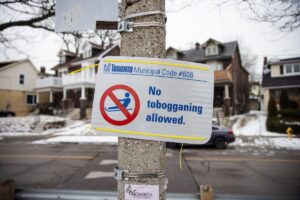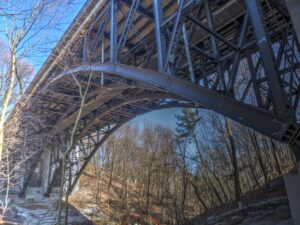January 24: When I was in late public school, I went tobogganing with my friends in a neighbours back yard that went downhill to the Yellow Creek ravine. It was not a long hill but if you got going fast enough, you went over the edge of the yard itself, and then rapidly downhill through bushes and the occasional tree into the ravine itself. It was here that I fell walking back up the icy hill and put my top teeth through my bottom lip, creating a scar I bear to this day.
 Some years later and admittedly with the assistance of recreational narcotics, some friends and I decided that we should try to toboggan down the access road from David Balfour Park into the opposite side of the ravine. The fact that it was entirely covered in ice only added to the potential for excitement. Of course, about half-way down the hill, we left the road at a high rate of speed and careened into the trees, fortunately without significant injury.
Some years later and admittedly with the assistance of recreational narcotics, some friends and I decided that we should try to toboggan down the access road from David Balfour Park into the opposite side of the ravine. The fact that it was entirely covered in ice only added to the potential for excitement. Of course, about half-way down the hill, we left the road at a high rate of speed and careened into the trees, fortunately without significant injury.
 The same ravine was crossed by the St. Clair viaduct. The bridge was built on arched beams that spanned from one side of the river to the other. Vertical box beams that resembled ladders reached up 25 or 30 meters to the bottom of the deck where there was a catwalk. We spent many happy hours climbing over the top of the arches and up the outside of the box beams to the catwalk. You might be fooled into thinking that the catwalk was a safe refuge, but of course it was as old as the bridge itself (say 60 years), and suspended from the bottom of the bridge deck by rusted rods that swayed with the added weight of a couple of 12 year-olds. And the boards that made up the walkway were rotting out. No worries
The same ravine was crossed by the St. Clair viaduct. The bridge was built on arched beams that spanned from one side of the river to the other. Vertical box beams that resembled ladders reached up 25 or 30 meters to the bottom of the deck where there was a catwalk. We spent many happy hours climbing over the top of the arches and up the outside of the box beams to the catwalk. You might be fooled into thinking that the catwalk was a safe refuge, but of course it was as old as the bridge itself (say 60 years), and suspended from the bottom of the bridge deck by rusted rods that swayed with the added weight of a couple of 12 year-olds. And the boards that made up the walkway were rotting out. No worries
A recent Toronto Star article tells us that the City is considering closing as many as 45 hills to tobogganing citing the potential danger of collision with fixed objects such as fences, trees and light standards on the hills. I understand this decision from the very narrow perspective of a taxpayer not wanting the City to be sued after a toboggan collision. But the same article quotes Mariana Brussoni, a developmental psychologist and professor at UBC’s Faculty of Medicine, who states that taking risks breeds confidence in children, as well as an improved ability to manage stress, uncertainty and anxiety. “We’re robbing kids of opportunities to get those positive effects. So what we’re seeing is a huge increase in children’s depression and anxiety.
According to a paper by Brussoni, studies have shown that children allowed to participate in risky play get better at detecting risk and show increased self-esteem and decreased sensitivity to conflict, Risky play also helps develop motor skills, social behaviour, independence and conflict resolution and even improves “the ability to negotiate decisions about substance use, relationships and sexual behaviour during adolescence,” according to supporting research cited in the paper.
Trying to reduce the risk to children by closing hills is part of a trend that has been unfolding for decades. You need only go by a school during the morning or afternoon rush to see fleets of gigantic SUV’s dropping off kids who are no longer permitted to walk the few blocks to school, never mind taking an apparently death-defying run down an icy hill on a toboggan. I think we are doing kids a great disservice by not letting them explore danger. Yes they may put their teeth through their lip, or break a bone, but in the process, they learn valuable lessons about themselves and the world in which they live.
Toronto’s tobogganing bans: The unintended consequences (thestar.com)
position-statement-on-active-outdoor-play-en.pdf (outdoorplaycanada.ca)